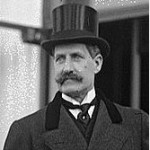Preparation of Memorandum
The 5 September 1929, before the Tenth Assembly of the League of Nations, Aristide Briand launched the idea of the institution’ “a sort of federal link” between European countries to have “at all times the possibility of contact, discuss their interests, take joint resolutions, to establish between them a bond of solidarity [ and] enable them to cope, timely, in serious circumstances, should they arise ".
The 9, representatives 27 European members of the League will meet them at the Hôtel des Bergues, give their consent and unanimity charge of France to prepare a document that will be submitted and reviewed collectively.
It works at the Ministry of Foreign Affairs during the winter, several projects are being developed, Briand charge Alexis Leger, his chief of staff, of writing paper. He made the choice of youth and ambition against the tradition embodied by the Secretary General of the Ministry of Foreign Affairs, Philippe Berthelot (photo-cons). This is marginalized. Alexis Leger finished writing the document on May 1 (the manuscript is now preserved in the archives of the Ministry of Foreign Affairs). It is printed, addressed to European capitals and disseminated in the press 17.
A number of movements, particularly dominant French, such as the European Union or the European Customs Cooperation boasted of having had a great influence on European projects Aristide Briand. It is true that the Quai d'Orsay follows closely the work of these organizations it funds and whose analyzes are visible reflected in the French diplomatic projects. Certainly Briand is based on the pan-European movement calling for the creation of a federal Europe. Here for ideas. But what about their practical translation in the document, what is the share of each in its design ? Many have worked at the Ministry.
 Alexis Leger, with the confidence Briand, is by far the most ambitious and innovative, his approach is comprehensive and first policy. Berthelot, reduced to working in the shadows, is notoriously reluctant, as the number of officials, including René Massigli, Secretary of the French delegation to the League of Nations (photo-cons), Jacques Duparc Fouques-and Roger Seydoux, Members of the Delegation, who think Briand is too conciliatory with Germany, want to go slowly, have a more economic approach, insist on technical issues such as labor, social issues, le transit, reject the idea of common European bodies. Synthesis almost got on the basis of their project, enriched a few points taken from Leger, ce is the inverse, the ministers to tranché : the project will be primarily political, include joint bodies, as proposed by Leger, and evoke in fine some technical questions. It is not unfair to say that the Memorandum, in its design, is largely the work of Alexis Leger and his writing, entirely.
Alexis Leger, with the confidence Briand, is by far the most ambitious and innovative, his approach is comprehensive and first policy. Berthelot, reduced to working in the shadows, is notoriously reluctant, as the number of officials, including René Massigli, Secretary of the French delegation to the League of Nations (photo-cons), Jacques Duparc Fouques-and Roger Seydoux, Members of the Delegation, who think Briand is too conciliatory with Germany, want to go slowly, have a more economic approach, insist on technical issues such as labor, social issues, le transit, reject the idea of common European bodies. Synthesis almost got on the basis of their project, enriched a few points taken from Leger, ce is the inverse, the ministers to tranché : the project will be primarily political, include joint bodies, as proposed by Leger, and evoke in fine some technical questions. It is not unfair to say that the Memorandum, in its design, is largely the work of Alexis Leger and his writing, entirely.
Many documents (notes, observations) preparatory to the Memorandum and its text (manuscript, printed) in diplomatic archives in the Saint-John Perse Foundation. No trace of Fouques-Duparc. Three letters of Seydoux (from 1946) and its “so-called tribute to the memory of Alexis Leger but vitriolic”. It is indeed one of the people who have hurt the memory of Alexis Leger in their works, first and foremost is Massigli (products in Counterpoint in 1980). Berthelot is now in private correspondence (from 1916 the death of Berthelot 1934) in diplomatic archives.



